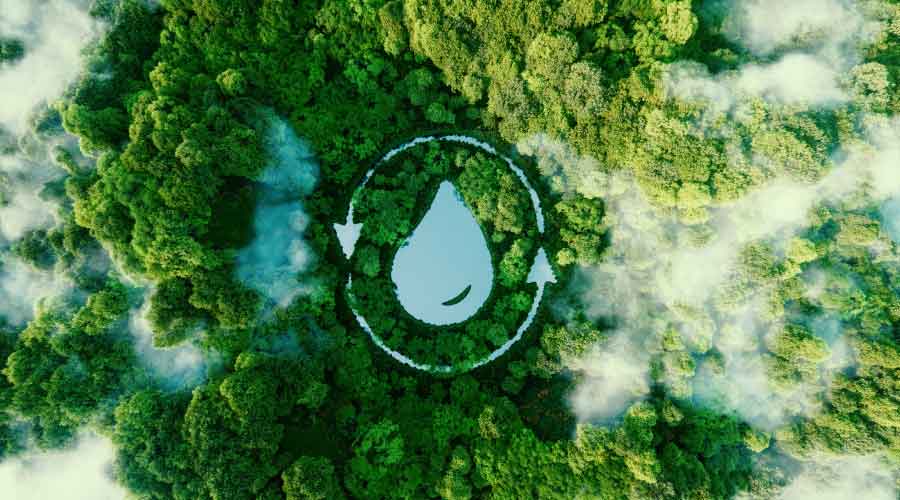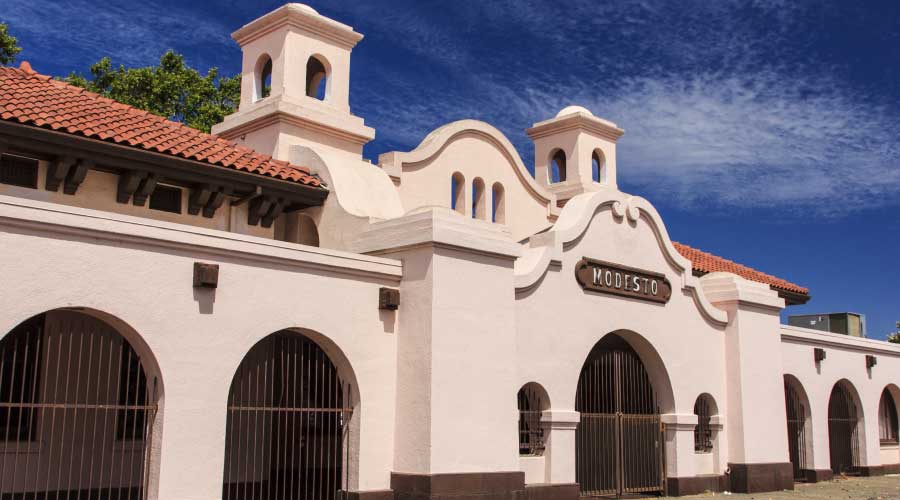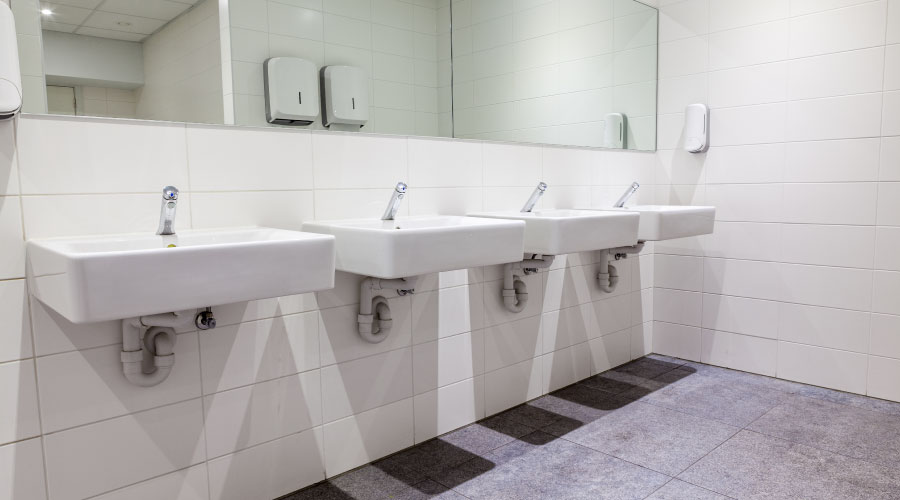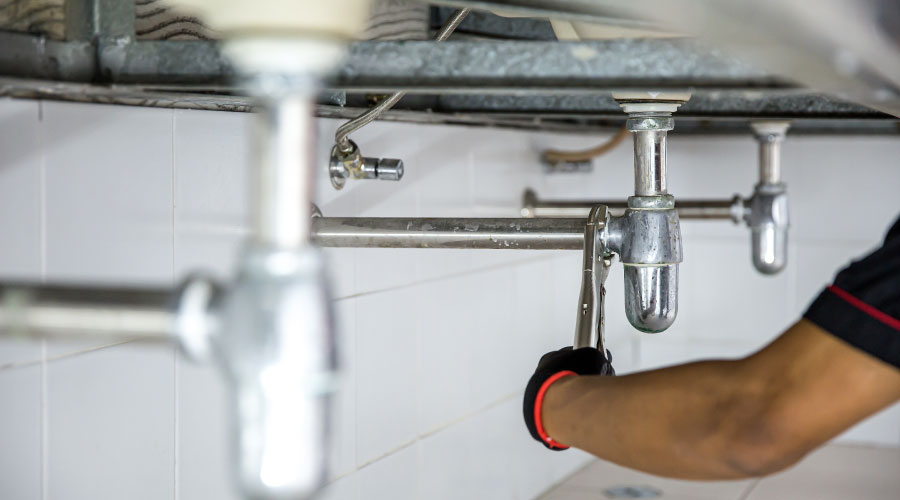3 Strategies for Water-Efficient Restrooms
As drought worsens over much of the country, saving water is more important than ever. Here’s how to do it.
By Greg Zimmerman, senior contributing editor
As climate change churns on beyond even worst-case-scenario predictions, drought continues to be pervasive in the U.S. By late July, more than 51 percent of the lower 48 states is classified to be in drought conditions, according to the National Integrated Drought Information System. That means more than 116 million people in the lower 48 states are currently being affected by drought. In some areas in the West, this ongoing 20-year drought is the driest period in more than 1,200 years, and the severe drought is expected to last until at least 2030. A recent report from NASA revealed that the country’s largest reservoir, Lake Mead, is currently at 27 percent of capacity and at its lowest level since 1937.
Conventional wisdom is that water is cheap and abundant; except when it’s not. And right now, water is neither cheap nor abundant. Water is unquestionably becoming more expensive, especially in those locations where the drought is the worst. But even if managers’ facilities are geographically located in a region not currently experiencing drought, chances are that won't always be the case. And just like the more than half the country in drought, managers will experience rate hikes, water shortages, and even water quotas. Water rates per thousand gallons in Chicago, for instance, have quadrupled since 2002.
General Services Administration data show that commercial buildings use 17 percent of all publicly supplied water in the U.S. Considering the amount of water used for farming and irrigation, thermoelectric generation, and industrial processes, it's almost surprising commercial buildings use nearly a fifth. So that 17 percent is a tremendous amount of water. A typical office building with about 200 occupants uses about 3,000 gallons of water per day. Restrooms are generally the biggest water-users in commercial buildings, using about 37 percent of a building’s water, according to the Environmental Protection Agency (EPA). So, anything facility managers can do to reduce water use in restrooms is beneficial for people, the planet, and profits.
Here are three important strategies for reducing water use in commercial facility restrooms, as well as tips to help facility managers justify, on a return-on-investment basis, money spent to improve water efficiency.
1.) Upgrade to WaterSense Fixtures
Flushing toilets and urinals, and running faucets are the major components of any commercial buildings’ water use. So, saving just a little on each flush or each wash of the hands can add up quickly in terms of both water savings and money savings. EPA estimates that about 26 percent of commercial toilets – more than 7 million of them – are using old standards of 3 to 7 gallons per flush. The current federal standard is lower at 1.6 gallons per flush, but even that is high by today’s standards of water efficient fixtures.
The EPA’s WaterSense program is recognized as the gold standard for labeling water-efficient restroom fixtures. As one example of a product in the program, WaterSense certifies flushometer-valve toilets that use no more than 1.28 gallons per flush, a 20 percent savings. EPA points out that in a 10-story office building with 1,000 occupants, savings can be 1.2 million gallons of water per year, which could be as much as $10,000 in savings depending on water rates. As well, a WaterSense certified toilet, according to the EPA, saves more than $1,000 over the life of the product, which makes for a pretty easy payback calculation. And that payback only gets better as the cost of water continues to rise.
Many commercial toilets now include smart features to use less water, or give users the option of a full flush or partial flush. But WaterSense specifies a minimum of 1 gallon per flush to ensure that products still operate effectively and don’t require more than one flush to clear the bowl.
Urinals are another big opportunity for savings. WaterSense-certified urinals use no more than 0.5 gallons per flush. Replacing just one water-intensive urinal that uses as much as 1.5 gallons per flush with a WaterSense product can save 1,500 gallons per year.
Finally, faucets and faucet accessories, like aerators, are a relatively inexpensive and easy way to save restroom water. WaterSense products are certified to reduce faucet flow rates from 2.2 gallons per minute to 1.5 gallons per minute, a savings of 30 percent. This is one area where water savings and energy savings can complement each other as well. Using less hot water means less energy, whether natural gas or electricity, is required to heat that water in facilities.
2. Adding Value Through Third-Party Certification
Saving water in the restroom isn’t just about saving money on the water bill. It can also literally add value to the building. That’s because water efficiency remains a staple of third-party green building certification systems like LEED and Green Globes. LEED-certified commercial facilities command rents as much as 20 percent higher than non-certified buildings, according to data from the U.S. Green Building Council.
So how do facility managers use water efficiency to help get a building LEED certified and achieve the goal of adding value to the organization? LEED v4.1 for Operations and Maintenance has one very crucial water efficiency-related prerequisite. A prerequisite in LEED is a strategy facility managers must execute in order to achieve any level of certification.
In this case, the water efficiency prerequisite is for baseline water performance. The prerequisite requires buildings to install water submeters and measure water use for 12 consecutive months. With a calculation (LEED shows users specifically how to do this calculation) that’s based on square footage, building occupancy, operating hours, and more, the building must achieve a minimum water performance score showing that the building is in the top-tier of buildings in terms of water efficiency. Any score above the baseline for water efficiency then earns LEED points. The higher the water performance score, the more LEED points earned towards a higher level of certification.
Green Globes for Existing Buildings’ treatment of water efficiency is a little more involved. For commercial buildings, the rating system offers two different paths to achieving points for overall water efficiency: peer benchmarking or prescriptive water performance. Green Globes then also offers points for individual water-conserving strategies, like choosing WaterSense fixtures.
As recruitment and retention of top talent becomes increasingly crucial, it’s incumbent upon facility managers to do anything they can to show how facilities add value to the organization. Similarly, for multi-tenant buildings, competition for stable tenants is fierce these days. Showing a potential tenant how sustainability strategies like water efficiency are consistent with their organization’s environmental commitment is a surefire way to help recruit tenants for whom sustainability is a core value.
3. No Water, No Problem?
Composting toilets, water reclamation and gray water systems, and waterless urinals are currently in use in various facilities all over the country – and with varying degrees of success. If facility managers are interested in taking the next step to these ultra-water-efficient technologies, how do they make sure they’ll work as expected?
One of the first steps is to make sure the water-efficient strategy in question actually meets the building code in the area, especially if doing a full-scale restroom renovation which may trigger a code review. Codes vary widely in different locations, so it’s incumbent on facility managers to make sure their water-efficiency strategy doesn’t run afoul of a code violation.
Organizations like Recode are working on writing model code language for cities and states to adopt water-efficient restroom strategies like composting toilets and waterless urinals into local building codes.
If facility managers can confirm, say, a water reclamation system or gray water recycling strategy is code-eligible, the next step is to select a system that will meet the needs of the facilities. Flushing toilets with reclaimed rain water is a strategy growing in popularity. One of the more famous examples is the Solaire building in New York City, which can reuse up to 25,000 gallons of water per day.
Whatever strategy facility managers choose, it’s increasingly clear that water efficiency cannot be ignored. Water efficiency is one of the rare strategies facility managers can employ that can contribute to the bottom line, add value to the organization, and reduce an organization’s environmental impact.
Greg Zimmerman is senior contributor editor for the facility group, which including FacilitiesNet.com and Building Operating Management magazine. He has more than 18 years’ experience writing about facility issues.
Related Topics:












